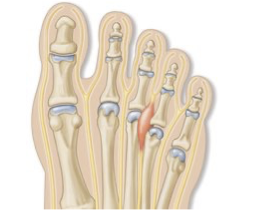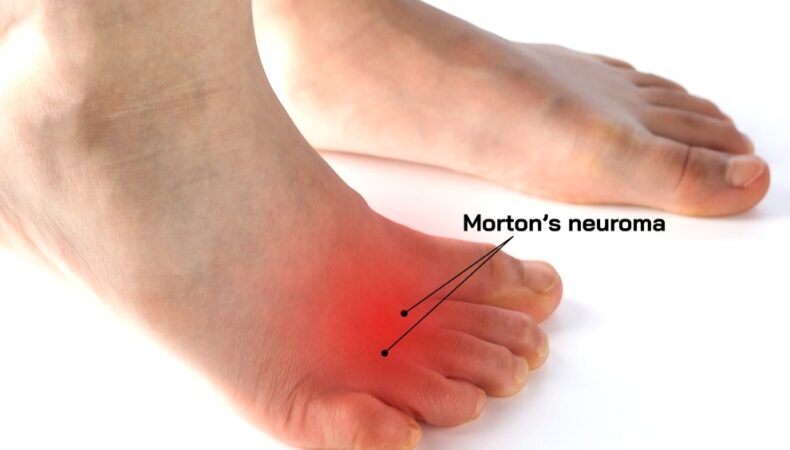What is Morton’s Neuroma?
Morton’s Neuroma is a condition characterized by the enlargement and inflammation of a nerve located in the “ball of the foot,” causing discomfort and pain.
Causes of Morton’s Neuroma
Morton’s Neuroma occurs when the nerve running to the toes becomes repetitively trapped in the ball of the foot during walking and standing, leading to swelling and inflammation. Factors contributing to nerve irritation include abnormal foot mechanics, tight calf muscles, and inappropriate footwear.
Symptoms of Morton’s Neuroma

The main symptoms of Morton’s Neuroma include pain in the ball of the foot and numbness or tingling sensations in the toes, which are often worse while walking or standing. Some individuals may feel as if a pebble is moving around under the ball of the foot, and there might be occasional clicking sensations. Morton’s Neuroma commonly affects the area between the second and third or third and fourth toes. If left untreated, the condition can worsen as the nerve enlarges.
Diagnosis of Morton’s Neuroma
Morton’s Neuroma is diagnosed based on your symptoms and a clinical examination. Your healthcare provider may also perform a foot X-ray to rule out other causes of foot pain. An ultrasound can be helpful in confirming the size and location of the Morton’s Neuroma.
Inter-metatarsal Bursitis
Inter-metatarsal bursitis is a condition where an inflamed fluid-filled sac forms between the long bones (metatarsals) or in the ball of the foot (metatarsal heads). The symptoms, causes, diagnosis, and treatment options for inter-metatarsal bursitis are similar to those of Morton’s Neuroma.
Treatment Options for Morton’s Neuroma
In most cases, initial treatment measures can effectively reduce symptoms and avoid the need for surgery. Here are some commonly recommended treatments for Morton’s Neuroma:
- Appropriate Footwear: Wear shoes with a wide toe box and thicker soles, while avoiding high heels.
- Orthoses (Medical Insoles): Medical insoles can improve foot function and reduce pain. Consult an Orthotist for a specialist opinion.
- Activity Modification: Modify activities that cause pain to alleviate symptoms.
- Stretching Exercises: Perform specific calf muscle stretches to reduce pressure on the ball of the foot during walking and standing.
- Injection Therapy: Steroid injections can help reduce inflammation around the nerve and relieve pain. However, repeated injections are generally not recommended.
When to Consider Seeing a Surgeon
If non-surgical treatments fail to provide relief and your symptoms persist or worsen, it may be appropriate to consult with Mr Barrett in Cambridge, UK. I am a consultant orthopaedic surgeon specialising in foot and ankle conditions.
Surgical intervention for Morton’s Neuroma is typically considered a last resort when conservative treatments have been exhausted. I will evaluate your case and discuss the treatment options available based on the severity of your symptoms and your overall medical condition.
Wellbeing Advice
Prior to surgery, maintaining a healthy diet, engaging in regular exercise, and refraining from smoking can contribute to a quicker and more successful recovery. If you have concerns about your general health and well-being, including diet, exercise, or smoking cessation, it is recommended to discuss these with your GP in Cambridge, UK, who can provide advice on available options.
For more information or to schedule an appointment in Cambridge, contact me using the form at the end of this page, or call 01223 618 630.
More information about Morton neuroma injections.
More information about Mortons neuroma surgery.
Remember, this information is not a substitute for medical advice. Please consult your healthcare provider for personalized advice and treatment options related to your specific condition.
Useful links:
https://www.nhs.uk/conditions/mortons-neuroma/
foot health Morton's Neuroma treatment non-surgical options surgical interventions
Last modified: June 22, 2023







